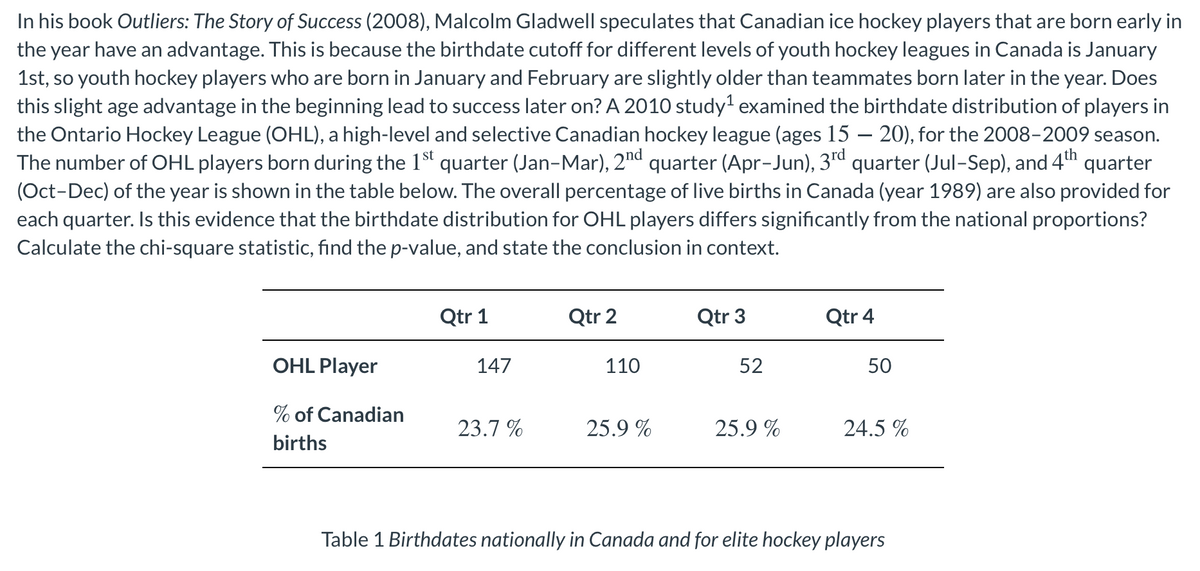In his book Outliers: The Story of Success (2008), Malcolm Gladwell speculates that Canadian ice hockey players that are born early in the year have an advantage. This is because the birthdate cutoff for different levels of youth hockey leagues in Canada is January 1st, so youth hockey players who are born in January and February are slightly older than teammates born later in the year. Does this slight age advantage in the beginning lead to success later on? A 2010 study' examined the birthdate distribution of players in the Ontario Hockey League (OHL), a high-level and selective Canadian hockey league (ages 15 – 20), for the 2008-2009 season. The number of OHL players born during the 1st quarter (Jan-Mar), 2nd quarter (Apr-Jun), 3rd quarter (Jul-Sep), and 4th quarter (Oct-Dec) of the year is shown in the table below. The overall percentage of live births in Canada (year 1989) are also provided for each quarter. Is this evidence that the birthdate distribution for OHL players differs significantly from the national proportions? Calculate the chi-square statistic, find the p-value, and state the conclusion in context. Qtr 1 Qtr 2 Qtr 3 Qtr 4 OHL Player 147 110 52 50 % of Canadian 23.7 % 25.9 % 25.9 % 24.5 % births Table 1 Birthdates nationally in Canada and for elite hockey players
In his book Outliers: The Story of Success (2008), Malcolm Gladwell speculates that Canadian ice hockey players that are born early in the year have an advantage. This is because the birthdate cutoff for different levels of youth hockey leagues in Canada is January 1st, so youth hockey players who are born in January and February are slightly older than teammates born later in the year. Does this slight age advantage in the beginning lead to success later on? A 2010 study' examined the birthdate distribution of players in the Ontario Hockey League (OHL), a high-level and selective Canadian hockey league (ages 15 – 20), for the 2008-2009 season. The number of OHL players born during the 1st quarter (Jan-Mar), 2nd quarter (Apr-Jun), 3rd quarter (Jul-Sep), and 4th quarter (Oct-Dec) of the year is shown in the table below. The overall percentage of live births in Canada (year 1989) are also provided for each quarter. Is this evidence that the birthdate distribution for OHL players differs significantly from the national proportions? Calculate the chi-square statistic, find the p-value, and state the conclusion in context. Qtr 1 Qtr 2 Qtr 3 Qtr 4 OHL Player 147 110 52 50 % of Canadian 23.7 % 25.9 % 25.9 % 24.5 % births Table 1 Birthdates nationally in Canada and for elite hockey players
Holt Mcdougal Larson Pre-algebra: Student Edition 2012
1st Edition
ISBN:9780547587776
Author:HOLT MCDOUGAL
Publisher:HOLT MCDOUGAL
Chapter11: Data Analysis And Probability
Section: Chapter Questions
Problem 8CR
Related questions
Question
Calculate the chi-square test statistic and the p-value.
Round your answer for the chi-square statistic to two decimal places, and your answer for the p-value to three decimal places.
X^2 :
p-value :

Transcribed Image Text:In his book Outliers: The Story of Success (2008), Malcolm Gladwell speculates that Canadian ice hockey players that are born early in
the year have an advantage. This is because the birthdate cutoff for different levels of youth hockey leagues in Canada is January
1st, so youth hockey players who are born in January and February are slightly older than teammates born later in the year. Does
this slight age advantage in the beginning lead to success later on? A 2010 study' examined the birthdate distribution of players in
the Ontario Hockey League (OHL), a high-level and selective Canadian hockey league (ages 15 – 20), for the 2008-2009 season.
The number of OHL players born during the 1st quarter (Jan-Mar), 2nd quarter (Apr-Jun), 3rd quarter (Jul-Sep), and 4th
(Oct-Dec) of the year is shown in the table below. The overall percentage of live births in Canada (year 1989) are also provided for
each quarter. Is this evidence that the birthdate distribution for OHL players differs significantly from the national proportions?
Calculate the chi-square statistic, find the p-value, and state the conclusion in context.
quarter
Qtr 1
Qtr 2
Qtr 3
Qtr 4
OHL Player
147
110
52
50
% of Canadian
23.7 %
25.9 %
25.9 %
24.5 %
births
Table 1 Birthdates nationally in Canada and for elite hockey players
Expert Solution
This question has been solved!
Explore an expertly crafted, step-by-step solution for a thorough understanding of key concepts.
This is a popular solution!
Trending now
This is a popular solution!
Step by step
Solved in 2 steps

Knowledge Booster
Learn more about
Need a deep-dive on the concept behind this application? Look no further. Learn more about this topic, statistics and related others by exploring similar questions and additional content below.Recommended textbooks for you

Holt Mcdougal Larson Pre-algebra: Student Edition…
Algebra
ISBN:
9780547587776
Author:
HOLT MCDOUGAL
Publisher:
HOLT MCDOUGAL

Glencoe Algebra 1, Student Edition, 9780079039897…
Algebra
ISBN:
9780079039897
Author:
Carter
Publisher:
McGraw Hill

College Algebra (MindTap Course List)
Algebra
ISBN:
9781305652231
Author:
R. David Gustafson, Jeff Hughes
Publisher:
Cengage Learning

Holt Mcdougal Larson Pre-algebra: Student Edition…
Algebra
ISBN:
9780547587776
Author:
HOLT MCDOUGAL
Publisher:
HOLT MCDOUGAL

Glencoe Algebra 1, Student Edition, 9780079039897…
Algebra
ISBN:
9780079039897
Author:
Carter
Publisher:
McGraw Hill

College Algebra (MindTap Course List)
Algebra
ISBN:
9781305652231
Author:
R. David Gustafson, Jeff Hughes
Publisher:
Cengage Learning